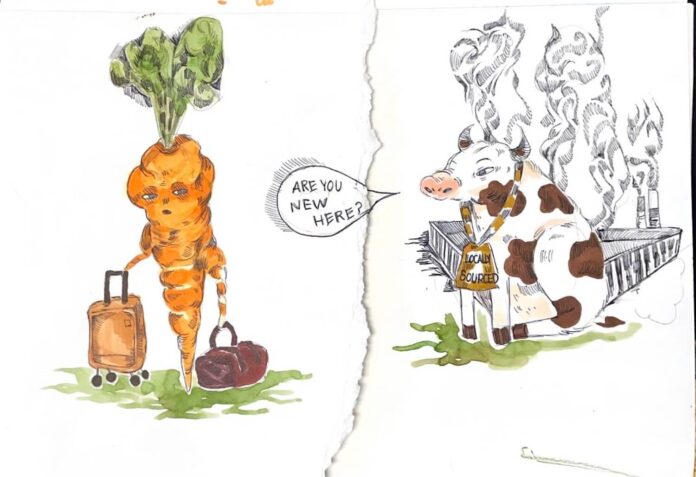When one walks out of the Marketplace after getting their meal or a snack, they encounter wall art (photo is mine) that provides advice for diners to be more environmentally conscious and sustainable in their choices. Examples include using an eco-clamshell — quite a good idea if you want to take food outside — and using a reusable coffee cup or water bottle. However, on the left side of the picture, focusing on food choices, one of the suggestions caught my eye. Or rather, the lack of a suggestion.
The wall art recommends eating food that is “ecologically sound” and “locally sourced,” as a way to have more sustainable eating choices. Yet, this kind of advice sidesteps the primary issue — the bulk of carbon emissions from food does not come from its location, nor even its waste. According to Our World in Data, only 4.8 percent of total food system emissions come from transporting food around the world, and 8.6 percent from food waste. Compare that to 32 percent of emissions produced by the changes in land use that occur to grow food, and 39 percent directly caused by producing the food across the entirety of the food system.
In another article for Our World in Data, Oxford researcher Hannah Ritchie calculated the effects of transportation on carbon emissions from beef or lamb, and found it was under 1 percent. Essentially, it is not where our food comes from that matters, but what the food is.
For instance, when one takes into account all the various carbon emission factors, a kilogram of beef from a beef cow emits upwards of 60 CO2-equivalent kilograms of greenhouse gas, compared to 4 CO2-equivalent kilograms of greenhouse gas per kilogram of rice and 0.3 per kilogram of nuts. When one looks at emissions per 1000 food calories, the difference becomes even more profound: 36.4 CO2-equivalent kilograms for beef cows versus 1.21 for rice and 0.07 for nuts.
If “sustainability” means reducing our carbon impact, then eating local meat is hardy any better than eating globally sourced meat — both have a strong negative impact on climate change, and to act like eating local meat absolves us of carbon impacts is woefully shortsighted.
Of course, beef and dairy products do not just emit lots of greenhouse gas in their production, they are also some of the most water-intensive foods out there. Around 80 percent of California’s water is used for agriculture — of that, 14 percent is for alfalfa (which is primarily feed for cows) and 9 percent is pasture, again primarily for cattle. Meanwhile, about 14 percent of our water is used for all urban use (yes, including lawns and golf courses).
Ordinary urban-resident Californians constantly hear pleas to cut back our water usage from our local water authority, and time and again we are able to meet these aggressive targets — Los Angeles has reduced its total water consumption since 1970, even as its population has increased substantially. But all of these efforts are a drop in the bucket compared to the water savings that would come from cutting back our meat and dairy consumption.
I’m a vegetarian, primarily because of path dependence — I was raised vegetarian in accordance with my parents’ religion — but understanding these facts about carbon emissions from food have emboldened my personal desire to stay as one. Even then, I still love dairy products such as milk, yogurt and cheese, and I don’t think you’re a bad person if you aren’t vegetarian or vegan.
If you’re hesitant about taking the plunge into vegetarianism or veganism, have faith. Thanks to the miracles of modern research and technology, there are copious meat substitutes that provide a similar taste and texture to modern meat. If you eat beef burgers at the Tiger Cooler, I recommend trying the Beyond Burger as a replacement. Even then, you don’t have to go full cold-turkey on meat — simply replacing a few meals each week with vegetarian, vegan or less carbon-intensive meat options will have a sizable impact on the climate when taken in aggregate.
Americans eat far, far more meat than our Organization for Economic Cooperation and Development (OECD) peers. Though Oxy students are surely more conscious than most about the necessity of reducing our meat consumption (as evidenced by the bounty of vegetarian and vegan options in campus dining), the college, administration and campus dining could always do more to encourage more vegetarian eating. This can be as simple as increasing the visibility of meat substitutes on dining menus or pricing meat dishes commensurate with their effect on the environment.
If we believe (correctly) that decarbonizing the food system is necessary to fight the red-alert threat that is climate change, then we should not be coy and let localist pastoral beliefs get the better of us. A local, grass-fed beef steak is still beef, and we need to eat less of it. I have faith that we can reduce meat consumption on campus, and in doing so, greatly reduce our carbon impact.
![]()



































